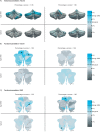Population-wide cerebellar growth models of children and adolescents
- PMID: 38499518
- PMCID: PMC10948906
- DOI: 10.1038/s41467-024-46398-2
Population-wide cerebellar growth models of children and adolescents
Abstract
In the past, the cerebellum has been best known for its crucial role in motor function. However, increasingly more findings highlight the importance of cerebellar contributions in cognitive functions and neurodevelopment. Using a total of 7240 neuroimaging scans from 4862 individuals, we describe and provide detailed, openly available models of cerebellar development in childhood and adolescence (age range: 6-17 years), an important time period for brain development and onset of neuropsychiatric disorders. Next to a traditionally used anatomical parcellation of the cerebellum, we generated growth models based on a recently proposed functional parcellation. In both, we find an anterior-posterior growth gradient mirroring the age-related improvements of underlying behavior and function, which is analogous to cerebral maturation patterns and offers evidence for directly related cerebello-cortical developmental trajectories. Finally, we illustrate how the current approach can be used to detect cerebellar abnormalities in clinical samples.
© 2024. The Author(s).
Conflict of interest statement
The authors declare no competing interests.
Figures






Similar articles
-
Connectivity of the Cerebello-Thalamo-Cortical Pathway in Survivors of Childhood Leukemia Treated With Chemotherapy Only.JAMA Netw Open. 2020 Nov 2;3(11):e2025839. doi: 10.1001/jamanetworkopen.2020.25839. JAMA Netw Open. 2020. PMID: 33216140 Free PMC article.
-
Cerebellum development during childhood and adolescence: a longitudinal morphometric MRI study.Neuroimage. 2010 Jan 1;49(1):63-70. doi: 10.1016/j.neuroimage.2009.08.016. Epub 2009 Aug 13. Neuroimage. 2010. PMID: 19683586 Free PMC article.
-
Functional topography of the human cerebellum.Handb Clin Neurol. 2018;154:59-70. doi: 10.1016/B978-0-444-63956-1.00004-7. Handb Clin Neurol. 2018. PMID: 29903452 Review.
-
The cerebellum and cognition: evidence from functional imaging studies.Cerebellum. 2012 Jun;11(2):352-65. doi: 10.1007/s12311-011-0260-7. Cerebellum. 2012. PMID: 21373864 Review.
-
The cerebellum in cognitive processes: supporting studies in children.Cerebellum. 2007;6(3):237-41. doi: 10.1080/14734220701344507. Cerebellum. 2007. PMID: 17786820 Review.
Cited by
-
How growing up without siblings affects the adult brain and behaviour in the CHIMGEN cohort.Nat Hum Behav. 2025 May;9(5):1005-1022. doi: 10.1038/s41562-025-02142-4. Epub 2025 Mar 31. Nat Hum Behav. 2025. PMID: 40164915
-
Dev-Atlas: A reference atlas of functional brain networks for typically developing adolescents.Dev Cogn Neurosci. 2025 Apr;72:101523. doi: 10.1016/j.dcn.2025.101523. Epub 2025 Feb 7. Dev Cogn Neurosci. 2025. PMID: 39938145 Free PMC article.
-
A bias-accounting meta-analytic approach refines and expands the cerebellar behavioral topography.bioRxiv [Preprint]. 2025 Jun 7:2024.10.31.621398. doi: 10.1101/2024.10.31.621398. bioRxiv. 2025. PMID: 39553998 Free PMC article. Preprint.
-
A hierarchical atlas of the human cerebellum for functional precision mapping.bioRxiv [Preprint]. 2024 Jun 1:2023.09.14.557689. doi: 10.1101/2023.09.14.557689. bioRxiv. 2024. Update in: Nat Commun. 2024 Sep 27;15(1):8376. doi: 10.1038/s41467-024-52371-w. PMID: 38260680 Free PMC article. Updated. Preprint.
-
Heritability of cerebellar subregion volumes in adolescent and young adult twins.Hum Brain Mapp. 2024 Jun 1;45(8):e26717. doi: 10.1002/hbm.26717. Hum Brain Mapp. 2024. PMID: 38798116 Free PMC article.
References
MeSH terms
Grants and funding
LinkOut - more resources
Full Text Sources
Miscellaneous

